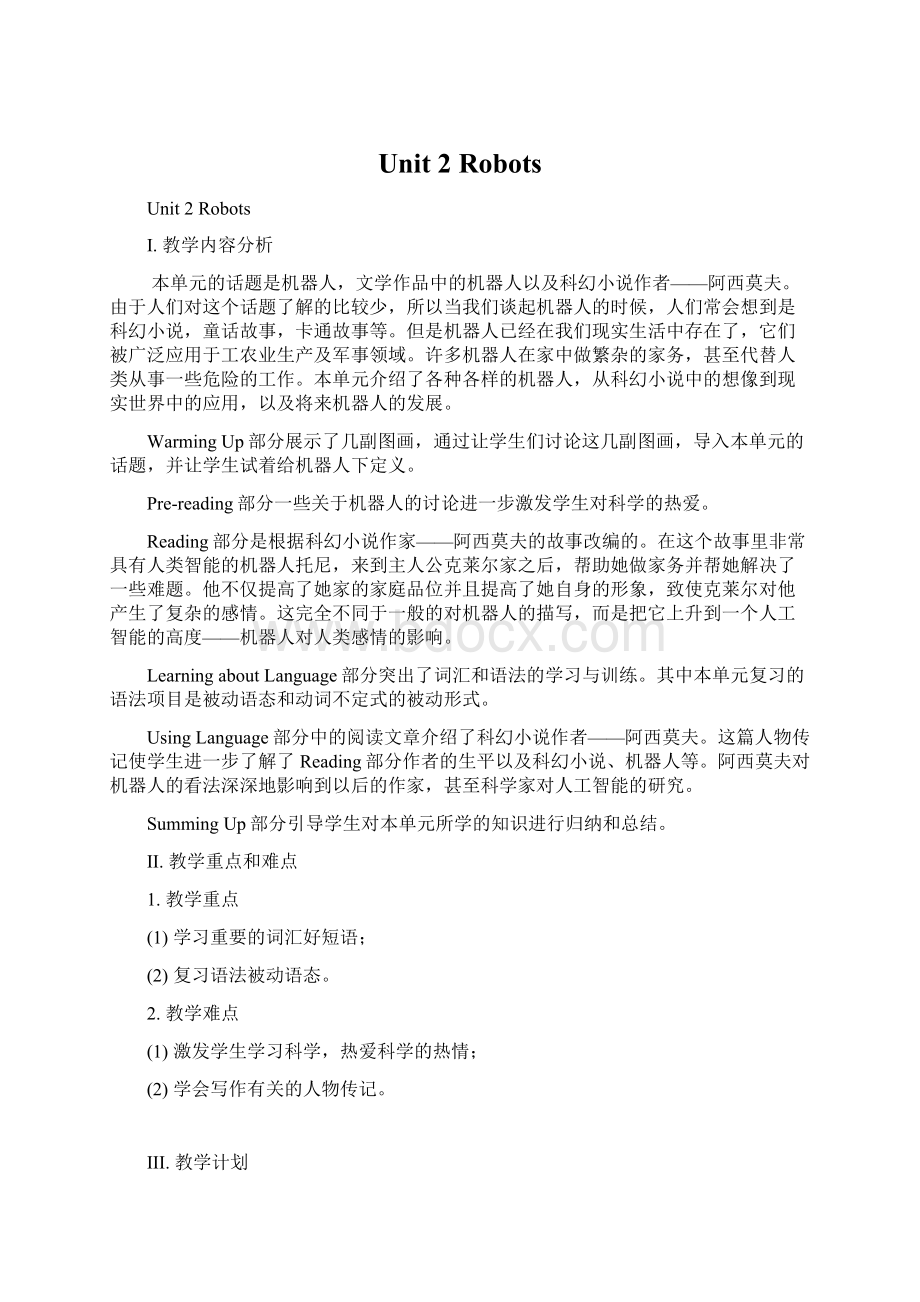Unit 2Robots.docx
《Unit 2Robots.docx》由会员分享,可在线阅读,更多相关《Unit 2Robots.docx(16页珍藏版)》请在冰豆网上搜索。

Unit2Robots
Unit2Robots
I.教学内容分析
本单元的话题是机器人,文学作品中的机器人以及科幻小说作者——阿西莫夫。
由于人们对这个话题了解的比较少,所以当我们谈起机器人的时候,人们常会想到是科幻小说,童话故事,卡通故事等。
但是机器人已经在我们现实生活中存在了,它们被广泛应用于工农业生产及军事领域。
许多机器人在家中做繁杂的家务,甚至代替人类从事一些危险的工作。
本单元介绍了各种各样的机器人,从科幻小说中的想像到现实世界中的应用,以及将来机器人的发展。
WarmingUp部分展示了几副图画,通过让学生们讨论这几副图画,导入本单元的话题,并让学生试着给机器人下定义。
Pre-reading部分一些关于机器人的讨论进一步激发学生对科学的热爱。
Reading部分是根据科幻小说作家——阿西莫夫的故事改编的。
在这个故事里非常具有人类智能的机器人托尼,来到主人公克莱尔家之后,帮助她做家务并帮她解决了一些难题。
他不仅提高了她家的家庭品位并且提高了她自身的形象,致使克莱尔对他产生了复杂的感情。
这完全不同于一般的对机器人的描写,而是把它上升到一个人工智能的高度——机器人对人类感情的影响。
LearningaboutLanguage部分突出了词汇和语法的学习与训练。
其中本单元复习的语法项目是被动语态和动词不定式的被动形式。
UsingLanguage部分中的阅读文章介绍了科幻小说作者——阿西莫夫。
这篇人物传记使学生进一步了解了Reading部分作者的生平以及科幻小说、机器人等。
阿西莫夫对机器人的看法深深地影响到以后的作家,甚至科学家对人工智能的研究。
SummingUp部分引导学生对本单元所学的知识进行归纳和总结。
II.教学重点和难点
1.教学重点
(1)学习重要的词汇好短语;
(2)复习语法被动语态。
2.教学难点
(1)激发学生学习科学,热爱科学的热情;
(2)学会写作有关的人物传记。
III.教学计划
本单元建议分为五个课时
第一课时:
WarmingUp&Listening(Workbook)
第二课时:
Pre-reading,Reading&Comprehending
第三、四课时:
LearningaboutLanguage
第五课时:
UsingLanguage
IV.教学步骤:
Period1WarmingUp&Listening(Workbook)
TeachingGoals:
1.Todiscussdifferentkindsofrobotsandtheirfunctions.
2.Toknowmoreabouttoday’srobots.
TeachingProcedures
Step1.Leading-in
1.TellSssomethingaboutrobotsandarousetheirinterestinrobots.
Robotsaregoodatdoingthesametaskoverandoveragain,exactlythesameway.Allrobotsaremachines.Theyhavecomputerinstructions.Theypaintcars.Theyliftheavyloads.Theyentersomeareasthosearetoodangerousforman.Somerobotshavedifferentshapes.Somearesimplyarms.Robotswithdifferentshapescandodifferentwork.Peoplecancontroltheserobotsfromadistance.
2.AskSstotalkaboutthefollowingquestions.
(1)Doyouknowanyrobots?
(2)What’sthecharacteristicofrobots?
(3)What’sthefunctionofrobots?
(4)What’sthedefinitionofarobotinyouopinion?
Step2.WarmingUp
1.AskSstoreadtheintroductionofrobotsinWarmingUpandcomparewiththeirideasaboutrobots.
2.AskSstotalkaboutthepicturesofWarmingUpandmakealistofanythingwithrobotsascharacters.Thenletthempresenttheirlistbeforetheclass.
3.AskSstoreadthefollowingtextandthenfinishthetrueorfalsequestions.
Henrywantstoborrowabookfromthelibrary.Hecomestothelibrarywithhisclassmates.Theycan'tseeanyassistantinit,butonlysomerobotsstandingthere.Henrysaystotherobot,“Hey,givemeabookonmusic.”Buttherobotdoesn'tmove.ThenanotherstudenttellsHenry,“Youmustsay‘Excuseme’and‘please’firstwhenyouwantsomehelp.”Henrydoessoandtherobotbringsthebook.ButHenrycan'tgetthebookfromtherobot'shands.Hethinksforamoment,thenhesaysawordtotherobot.Therobotgiveshimthebook.Henrygetsthebookandgoeshomehappily.
(1)Thereisnoassistantinthislibrary.()
(2)Henrywantstolistentomusicinthelibrary.()
(3)Therobotdoesn'tmovefirstbecauseit'sbroken.()
(4)Teachersandrobotsworkinthelibrary.()
(5)Henrymaysay“Thanks”whenhewantstogetthebookfromtherobot.()
SuggestedAnswers:
(1)T
(2)F(3)F(4)F(5)T
Step3.Listening(Workbook)
1.LeadSstoListening.Teachermaysay,“Todaywearegoingtolistentoaradiointerviewinwhichasciencereportertalksaboutrecentrobots.Fromit,wecanlearnmoreabouttoday’srobots.Beforelisteningtothetape,pleaselookthroughtheexercisesonP54quickly.”
2.PlaythetapeandaskSstofinishEx2onP54.
3.AskSstoworkinpairs,listentothetapeandfinishEx3onP54.Playthetapeagainandaskthemtochecktheanswers.
4.AskSstodiscussthefollowingquestionsinpairs.
(1)WhatarethenegativeaspectsofeachrobotthatEmmatalksabout?
(2)Howcanwedealwiththenegativeaspectsofeachrobot?
Step4.Homework
1.AskSstosurftheInternetandfindsomeinformationaboutrobots.
2.AskSstopreviewthereadingtext.
Period2Pre-reading,Reading&Comprehending
TeachingGoals:
1.TogetSstoknowthelifeofTony.
2.TogetSstoknowmoreaboutwhatrobotscandoforpeople.
3.TodevelopSs’readingability.
TeachingProcedures:
Step1.Pre-reading
1.AskSstolookatthepicturesofPre-readingonP10anddiscussthefollowingquestions.
(1)Whatarethey?
(2)Wherecanwefindthem?
(3)Whatcantheydoforpeople?
2.AskSstoimaginearobotthatcanthink,feel,hasitsownneedsanddesires,andlooksandfeelslikeahumanbeing.Thenaskthemtotalkaboutthefollowingquestion.
Canwefindtherobotinourlife?
3.TellSsthattherobotcannotbefoundinourreallifebutwecanfinditinthetextwearegoingtolearnnext.
Step2.Fastreading
1.AskSstoreadthetextquicklyandtrytofindthemainideaofthetext.
2.AskSstofindtherelationshipsbetweenthecharactersinthetext.
SuggestedAnswers:
LarryBelmont—employedinacompanythatmakedrobots.
ClaireBelmont—Larry’swife,ahousewife
Tony—therobot
GladysClaffern—awomanthatClaireenvies
Step3.Intensivereading
1.AskSstoreadthetextcarefullyandanswerthequestionsinEx1onP12.
2.AskSstolookthroughthefollowingsentencesandtrytofindwhethertheyaretrueorfalseaccordingtothetext.
(1)Onthesecondmorning,TonybroughtClairebreakfastandthendressedher.(F)
(2)TonywantedtopleaseClairebyborrowingbooksfromthelibrary.(F)
(3)TonygaveClaireanewhaircutandmadeherup.(T)
(4)WhenClairefelloffaladder,Tonycaughther.(T)
(5)Atlast,peoplemanagedtohavewomenfallinginlovewithmachines.(F)
SuggestedAnswers:
(1)F
(2)F(3)T(4)T(5)F
3.Playthetape,andaskSstolistenandpayattentiontoTony’scharacteristicsthatweresimilartothoseofahumanbeinganddifferentfromthoseofahumanbeing.ThenaskthemtofinishEx2onP12.
Step4.Consolidation
1.AskSstolistentothetapeagainandtrytoretellthestory.
2.AskSstounderlinewhattheycannotunderstandinthetext.Andtellthemthelanguagepointswillbedealtwithinthenextperiod.
Step5.Homework
1.AskSstowritetheretoldstory.
2.AskSstopreviewLearningaboutLanguage.
Period3&4LearningaboutLanguage
TeachingGoal:
1.TogetSstomasterthenewwordsandexpressions.
2.TogetSstomasterthegrammarpoint:
thepassiveinfinitiveandv–edformasadjectives.
Step1.Wordstudy
1.fiction
(1)【U】小说
Hewritesfiction.他写小说。
(2)【C】杜撰的故事,虚构的事情
Itisonlyafictionnotafact.这件事是虚构的,不是事实。
2.desirevt希望,想要
Wealldesirehappinessandhealth.我们都想得到幸福和健康。
3.absentadj.
(1)缺席,不在
Hewasabsentfromthemeeting.他没有出席会议。
(2)缺少
Lovewastotallyabsentfromhischildhood.他从童年就完全失去了爱。
(3)漫不经心的,心不在焉的
Wecanseeanabsentexpressiononherface.我们能看到她脸上漫不经心的表情。
4.alarmed焦急的,害怕的
I’mveryalarmedatyourleaving.你打算离开,我相当焦急。
●拓展:
alarmvt使惊慌
Idon’twanttoalarmyou.我不想让你惊慌。
5.embarrassed
(1)感到不自然,窘迫
Iwasembarrassedbyhiscommentsaboutmyclothes.他对我的衣服说长道短,令我很难堪。
(2)精神上不安或焦虑
Hewasembarrassedbylackofmoney他因缺钱而焦虑不安。
6.sympathy
(1)同情,怜悯
SheneverexpressedanysympathyformewhenIwasinjured.我受伤时,她从来没表示过任何同情。
(2)同情,慰问
Youhavemydeepestsympathiesonthedeathofyourwife.对你妻子的逝世,我深表同情。
(3)同感,一致,协调
Abondofsympathydevelopedbetweenmembersofthegroup.该组成员间的凝聚力增强了。
(4)赞同,支持
Thesteelworkerscameoutinsympathywiththeminer.钢铁工人站出来支持矿工。
(5)同意,不同意
Heiswrong—Ihavenosympathywithhim.他错了,我于他毫无同感。
7.elegantadj文雅的,高雅的,精致的
Shewastallandelegant.她身材修长,优雅大方。
8.scanv
(1)仔细观察,仔细了望
Hescannedthehorizon.他仔细了望地平线。
(2)扫掠
Theflashlight’sbeamscannedeverycorneroftheroom.手电筒的光束把屋内各处都扫遍了。
(3)浏览
Shescannedthenewspaperoverbreakfast.她吃早饭时把报纸浏览了一遍。
8.absurdadj
(1)不合理的,不明智的
Whatanabsurdsuggestion!
多摸不合理的建议。
Iwasabsurdofyoutosuggestsuchathing.你提出这样的事是不明智的
(2)愚蠢的,可笑的
Thatuniformmakesthemlookabsurd.那种制服使他们看起来很滑稽。
10.awfuladj
(1)极坏的,可怕的
Theplightofstarvingpeopleistooawfultothinkabout.饥饿人们的困境坏的令人难以想象。
(2)非常坏的,极度的
whatawfulweather!
多糟糕的天气啊!
(3)极大的,非常的
Thatisanawfullotofmoney.那可是一大笔钱。
Iaminanawfulhurrytogettothebank.我非常急着要去银行。
11.affairn.
(1)事,事情
Itisnotmyaffair.这不是我的事。
(2)个人的事情
Youshouldputyouraffairsinorder.你应该理顺你的事情。
(3)公众的事物
Thoseareaffairsofstate.那些是国事。
12.firmlyadv稳固的,坚定的
Thefencepostswerefixedfirmlyintheground.篱笆桩被牢牢地埋在地里。
Thesuggestionwaspolitecybutfirmlyrejectedbythechairman.那建议被主席委婉地,但却坚决地拒绝了。
13.declarev
(1)f宣布,宣告,声明
Theydeclaredhim(tobe)thewinner.他们宣布他获胜。
(2)郑重地说
Hedeclaredthathewasinnocent.他声明他是无辜的
(3)赞成,反对
Thecommissiondeclaredagainsttheproposedscheme.委员会反对拟以的计划。
14.envyn
(1)嫉妒,羡慕
Hecouldn’tconcealhisenvyofmeyououtofenvy.他无法掩饰对我成功的嫉妒。
(2)嫉妒的对象,羡慕的目标
Hermanytalentsweretheenvyofallherfriends.她的多才多艺使朋友们羡慕。
(3)v嫉妒,羡慕
Idon’tenvyhimhismoney.
我可不羡慕他的钱。
Step2.Phrasestudy
1.testout考察,检验
Heisgoingtotestouttheresultoftheexperiment.他要检查一下实验的结果。
2.turnaround回转,转向
Whenheturnedaround,hefoundhisfriendgone.他转身发现他的朋友已经走了。
3.leavealone不管,不理会,不干涉
Leavethatmaddogalone.别理那条疯狗。
Step3.Sentencestudy
1.Itwasdisturbingandfrighteningthathelookedsohuman.他看上去太像人类了,这令人不安且害怕。
Itis/was+adj+that
Itwassurprisingthathehadfailedtheexam.他没有通过考试,真让人吃惊。
2.ItwasthenthatClairerealizedthatTonyhadopenedthecurtainsonthefrontwindow.就在那时,克莱尔发现托尼已经拉开了前窗的窗帘。
Itwas/is+被强调部分+that
ItwasyesterdaythatImetyoursisterinthezoo.就在昨天我在动物园遇见了你的姐姐。
ItwasinthezoothatImetyoursisteryesterday.昨天正是在那个动物园我遇见了你的姐姐。
Step4.Grammarstudy
1.Thepassiveinfinitive
(1)Explanation
当不定式动词与其逻辑主语之间是被动关系时,不定式要用被动语态构成形式为tobedone/tohavebeendone。
例如: